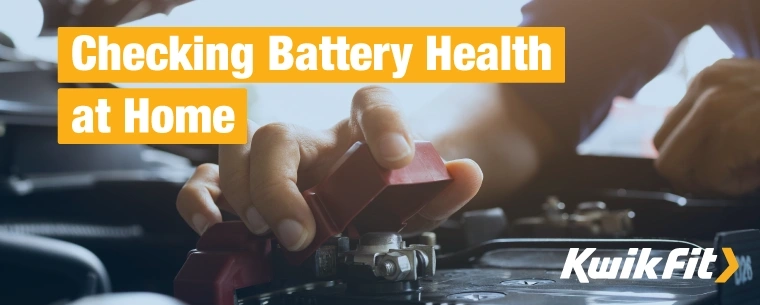Checking Battery Health at Home
Jack Dreyer | Monday 5th September 2022 12:30pm

Your car battery — it’s a crucial part of your vehicle that literally keeps your engine, your air conditioning, your music, and your electrical system running.
So what about when they give out on us? It’s more than an annoyance, and can make your everyday plans impossible until you’ve charged your battery, jump-started it, or, in the worst case scenario, have had it replaced! It follows, then, that keeping your battery in good health is well worth it.
In this blog, we’re going to take a look at some common factors that can impact your car battery and the ways you can check your battery health at home.
Common battery drains that impact its health

Flat batteries are the most common cause of vehicle breakdowns — possibly because there are simply so many things that impact battery health. Luckily, many of these things are avoidable.
- Car batteries naturally lose charge over time – The longer you leave your car without driving it, the more likely the battery is going to go flat and not have enough charge to start the car.
- Leaving something electrical on – like your headlights or an internal cabin light – can drain your battery.
- Cold weather – Batteries do not like the cold and on chilly mornings, your car battery has less charge available than normal to start the car. The older your battery is, the more susceptible it is to the cold!
- Short journeys – If your car never gets a good run, the battery will never receive a full charge, reducing its ability to hold charge and shortening its lifespan.
- Dirty & grimy battery terminals – These can prevent your battery from transferring power to the vehicle.
- A faulty component such as the alternator – This crucial component recharges your battery when the engine is running.
- Car batteries have a lifespan of about 5-7 years – Older batteries can’t recharge as effectively.
How to check your battery health at home

1. Check the voltage
You can buy a voltmeter for less than £20 these days, so it’s worth investing in one to regularly check your battery’s voltage. To test, make sure you first turn off any car accessories that could drain the battery, including the ignition, air conditioning, headlights, and the car radio.
Carefully remove the covers on the battery terminals and connect the positive side of the voltmeter to the positive (red) terminal first. Then connect the negative side of the voltmeter to the negative (black) terminal.
Now, check your reading. A healthy battery should read between 12.4V and 12.7V. A reading of just under — like 12.3V — can indicate your battery is only 75% charged.
2. Try the headlight test
Checking your car’s headlights can give you an indication of your battery health. Turn your car’s headlights on and check whether they look darker than they should be — if that’s the case, your battery may be low.
If you put your foot on the accelerator slightly and find that your headlights get brighter, that can indicate a faulty alternator which isn’t supplying enough current to your battery. Your headlights should stay at a stable brightness when revving.
3. Battery health indicator
Many modern cars come with batteries that have an in-built battery health indicator.
The indicator will have an arrow that turns either red or green depending on the state of the battery (red indicating low voltage and green indicating a good condition). When the battery is completely flat, nothing will show.
4. Physical check
You can tell surprisingly many things about your car battery’s health just from looking at it.
While it’s still in the engine bay, check for any corrosion using a good torch. Battery acid is corrosive so, should you notice a sulphuric smell or any bubbling or dried liquid, it’s best to take your car to the battery specialists.
If there are no cracks or liquid to be seen, you can remove your battery from the engine bay for a thorough inspection. Ensure you carefully remove the negative (black) terminal first, and the positive (red) terminal last to keep yourself safe. See full instructions here on how to remove the battery.
Check for any bulges, which can sometimes suggest overcharging. If there are any cracks, you need to get your battery replaced as soon as possible.
How to keep your car battery from dying

Fortunately, there are plenty of ways you can keep your battery from dying in the first place.
- Keep your battery terminals clean and free of debris
- Ensure that the connectors are tight and have not come loose
- Regularly carry out inspections & tests to get on top of small issues before they become big problems
- Start your engine up regularly and leave your car running for a little while
- Avoid driving at night or early in the morning when the weather is coldest
- Purchase a battery cover to protect it from the cold
- Clean away any corrosion from the terminals using a toothbrush and a solution of baking soda and water
- Buy a trickle charger to keep your car battery topped up
We also recommend checking the age of your battery to provide a good indication of whether it will need to be replaced soon. All car batteries are stamped with a code indicating the date that it was manufactured. The majority of car batteries are designed to last for 5 to 7 years; any longer than this and the battery will be more likely to fail, especially when cold.
Check out some more of our battery care and maintenance tips to help keep your car battery in tip top condition over the coming months.
Get a free battery health check
If you’re unsure about the condition of your car battery in the future, then why not find out more about our free battery checks?
Available at centres around the UK, we’ll check for corrosion on the terminals, as well as the voltage output and the charging rate of the battery - giving you a clear view on what condition your car battery is in.
Find out more about our free car battery health checks or book an appointment at your local centre today.
Any facts, figures and prices shown in our blog articles are correct at time of publication.
Featured Articles
Is Your Car Battery Ready for Winter?
Monday 11th November 2024
Is the UK on the verge of ‘the coldest winter for 50 years?’ Even if El Niño doesn't hit the UK this winter, reduce the risk of a winter breakdown by making sure your car battery is winter-ready.
Your Ultimate Winter Driving Checklist
Monday 31st October 2022
Driving in the colder months presents many challenges. Breakdowns are far more common in winter, so make sure you’re prepared with these essentials.
How to Get Your Car Ready for Winter
Wednesday 28th September 2022
Winter can be a harsh season for your car but planning ahead by carrying out some basic maintenance and packing some essential kit should help you avoid a winter breakdown.







